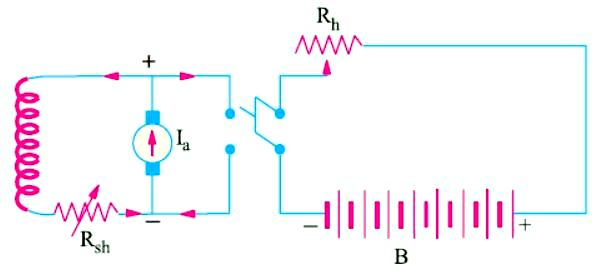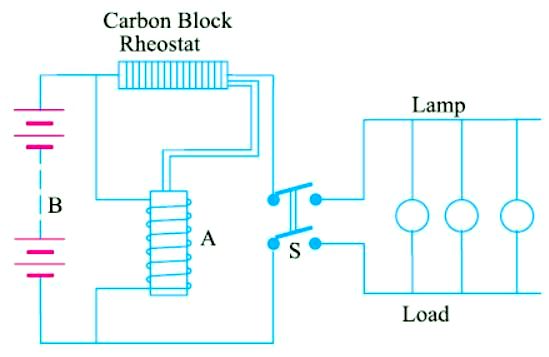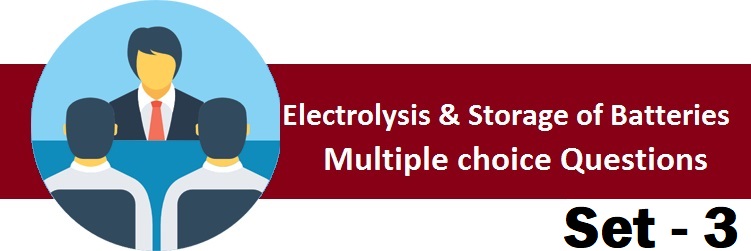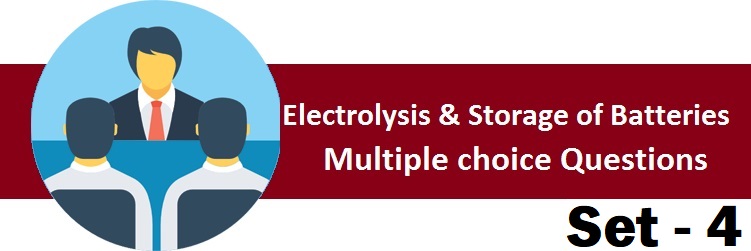Charging Systems
Charging System of batteries
In various installations, batteries are kept floating on the line and are so connected that they are being charged when load demands are light and automatically discharged during peak periods when load demands are heavy or when the usual power supply fails or is disconnected. In some other installations, the battery is connected to the feeder circuit as and when desired, allowed to discharge to a certain point, then removed and re-charged for further requirements (Charging system of batteries).
For charging system of batteries other than the ‘floating’ and ‘system-governed’ type, following two general methods (though there are some variations of these) are employed.
(i) The Constant-current System and
(ii) The Constant-voltage System.
(i) The Constant-current System
In this method, the charging current is kept constant by varying the supply voltage to overcome the increased back e.m.f. of cells. If a charging booster (which is just a shunt dynamo directly driven by a motor) is used, the current supplied by it can be kept constant by adjusting its excitations. If charged on a d.c. supply, the current is controlled by varying the rheostat connected in the circuit.

The value of charging current should be so chosen that there would be no excessive gassing during final stages of charging and, also, the cell temperature does not exceed 45°C. This method takes a comparatively longer time.
AdBlock-2
(ii) The Constant-voltage System.
In this method, the voltage is kept constant but it results in very large charging current in the beginning when the back e.m.f. of the cells is low and a small current when their back e.m.f. increases on being charged.
With this method, time of charging is almost reduced to half. It increases the capacity by approximately 20% but reduces the efficiency by 10% or so.
Calculations:
When a secondary cell or a battery of such cells is being charged, then the emf of the cells acts in opposition to the applied voltage. If V is the supply voltage which sends a charging current of I against the back e.m.f. Eb, then input is VI but the power spent in overcoming the opposition (Figure B) is EbI. This power EbI is converted into the chemical energy which is stored in the cell. The charging current can be found from the following equation :
![]()
where
R = total circuit resistance including internal resistance of the battery
I = charging current
By varying R, the charging current can be kept constant throughout.

Trickle Charging
Charging system of batteries : When a storage battery is kept entirely as an emergency reserve, it is very essential that it should be found fully charged and ready for service when an emergency arises. Due to leakage action and other open-circuit losses, the battery deteriorates even when idle or on open-circuit. Hence, to keep it fresh, the battery is kept on a trickle charge. The rate of trickle charge is small and is just sufficient to balance the open-circuit losses. For example, a standby battery for station bus-bars capable of giving 2000 A for 1 hour or 400 Ah at the 10-hr rate, will be having a normal charging rate of 555 A, but a continuous ‘trickle’ charge of 1 A or so will keep the cells fully charged (without any gassing) and in perfect condition. When during an emergency, the battery gets discharged, it is recharged at its normal charging rate and then is kept on a continuous trickle charge.
Indications of a Full-charged Cell
The indications of a fully-charged cell are :
(i) Gassing
(ii) Voltage
(iii) Specific gravity and
(iv) Colour of the plates.
(i) Gassing
When the cell is fully charged, it freely gives off hydrogen at cathode and oxygen at the anode, the process being known as “Gassing”. Gassing at both plates indicates that the current is no longer doing any useful work and hence should be stopped. Moreover, when the cell is fully charged, the electrolyte assumes a milky appearance.
(ii) Voltage
The voltage ceases to rise when the cell becomes fully-charged. The value of the voltage of a fully-charged cell is a variable quantity being affected by the rate of charging, the temperature and specific gravity of the electrolyte etc. The approximate value of the e.m.f. is 2.1 V or so.
(iii) Specific Gravity of the Electrolyte
A third indication of the state of charge of a battery is given by the specific gravity of the electrolyte. We have seen from the chemical equations of Chemical changes, that during discharging, the density of electrolyte decreases due to other production of water, whereas it increases during charging due to the absorption of water. The value of density when the cell is fully charged is 1.21 and 1.18 when discharged up to 1.8 V. Specific gravity can be measured with a suitable hydrometer which consists of a float, a chamber for the electrolyte and a squeeze bulb.
(iv) Colour
The colour plates, on full charge is deep chocolate brown for positive plate and clear slate gray for negative plate and the cell looks quite brisk and alive.
Voltage Regulators
Charging system of batteries : As explained in Article Electrical Characteristics of the Lead-acid Cell, the voltage of a battery varies over a considerable range while under discharge. Hence, it is necessary to find some means to control the battery voltage upto the end so as to confine variations within reasonable limits – these limits being supplied by the battery.
The voltage control systems may be hand-operated or automatic. The simplest form of hand-operated control consists of a rheostat having a sufficient number of steps so that assistance can be inserted in the circuit when battery is fully charged and gradually cut out as the discharge continues, as shown in Figure C.

The above system can be designed for automatic operation as shown in Figure D. A rise in voltage results in the release of pressure on the carbon block rheostat, thereby increasing its resistance whereas a fall in voltage results in increasing the pressure on the block thereby decreasing its resistance. By this automatic variation of control resistance, variations in battery voltage are automatically controlled.

End-cell Control System
Charging system of batteries : The use of rheostat for controlling the battery voltage is objectionable especially in large capacity installations where the I2R loss would be considerable. Hence other more economical systems have been developed and put into use. One such system is the end-cell control system. It consists of suitable regulator switches which cut one or more of a selected number of cells out of the circuit when the battery is fully charged and into the circuit again as the discharge continues. To make the process of cutting cells in and out at the battery circuit simple, the group of cells selected for this control is situated at one end of the battery where from it derives the name end cell. By moving the contact arm of the switch to the left or right, cells are cut in or out of the discharge circuit and so the voltage is varied accordingly.
For making the end-cell switch operate without opening the circuit or short circuiting the cells during its passage from one cell to another, an auxiliary constraint S2 is employed. S2 prevents the circuit from being open entirely but has sufficient resistance R between it and the main contact arm S1 to prevent any objectionably large current to flow on short-circuit. The above mechanism usually incorporates devices for preventing the stoppage of the switch in the short-circuit position.
Number of End-cells
Charging system of batteries : For maintaining a supply voltage of V volts from a battery of lead-acid cells when the latter are approaching their discharge voltage of 1.83 (depending on the discharge rate), the number of cells required is V/1.83. When the battery is fully charged with each cell having an e.m.f. of 2.1 V, then the number of cells required is V/2.1. Hence, the number of end-cells required is (V/1.83 − V/2.1). These are connected to a regulating switch which adds them in series with the battery one or two at a time, as the discharge proceeds.
Read article – Lead Acid Battery construction and working principle
Visit NCERTplanet.com for NCERT solutions and Textbook downloads




